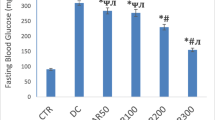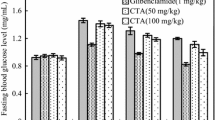Abstract
The severity of disturbances in carbohydrate metabolism in rats with alloxan-induced diabetes depended on activity of antioxidant enzymes in the target organ (pancreas). Damage to the pancreas is related to intensive generation of reactive oxygen species, free radicals, and lipid peroxides. Alloxan-induced diabetes in rats is a free radical disease, which in vivo serves as a useful model for the search for pharmacological preparations with antiradical and antioxidant properties. The antioxidant compound probucol indirectly increased activity of antioxidant enzymes in the pancreas and prevented the development of alloxan-induced diabetes in rats. Our results indicate that different sensitivity of laboratory animals of various species (rats and guinea pigs) to the influence of alloxan is associated with abnormal variations in activity of enzymes utilizing reactive oxygen species and lipid peroxides in mammalian pancreatic cells.
Similar content being viewed by others
REFERENCES
Biochemistry of Lipids and Their Role in Metabolism [in Russian], Ed. S. E. Severin, Moscow (1981), pp. 75–95.
N. K. Zenkov, N. V. Kandalintseva, V. Z. Lankin, et al., Phenol Antioxidants [in Russian], Novosibirsk (2003).
N. K. Zenkov, V. Z. Lankin, and E. B. Men'shchikova, Oxidative Stress. Biochemical and Pathophysiological Aspects [in Russian], Moscow (2001).
V. Z. Lankin, A. K. Tikhaze, and Yu. N. Belenkov, Kardiologiya, 40, No. 7, 48–61 (2000).
V. Z. Lankin, A. K. Tikhaze, and Yu. N. Belenkov, Free Radical Processes under Normal and Pathological Conditions (Manual for Physicians) [in Russian], Moscow (2001).
V. Z. Lankin, A. K. Tikhaze, A. L. Kovalevskaya, et al., Dokl. Akad. Nauk SSSR, 261, No. 6, 1467–1470 (1981).
V. I. Lapin, V. I. Korchin, G. G. Meiramov, et al., Pat. Fiziol., No. 4, 36–39 (1973).
L. V. Nedosugova, V. Z. Lankin, M. I. Balabolkin, et al., Byull. Eksp. Biol. Med., 136, No. 8, 152–155 (2003).
A. K. Tikhaze, V. Z. Lankin, V. P. Mikhin, et al., Ter. Arkh., 59, No. 9, 35–41 (1997).
C. Beauchamp and J. Fridovich, Anal. Biochem., 44, 276–278 (1971).
D. Kumar, V. Palace, I. Danelisen, et al., J. Mol. Cell. Cardiol., 33, A62 (2001).
V. Lankin, Free Radicals, Nitric Oxide, and Inflammation: Molecular, Biochemical, and Clinical Aspects, Amsterdam (2003), Vol. 344, pp. 8–23.
V. Z. Lankin, V. I. Korchin, G. G. Konovalova, et al., Free Radic. Biol. Med., 16, 15 (1994).
L. W. Oberley, Free Radic. Biol. Med., 5, 113–124 (1988).
R. Schmidt, Der Alloxandiabetes. Morphologie, Chemismus und Literatur, Leipzig (1967).
Author information
Authors and Affiliations
Rights and permissions
About this article
Cite this article
Lankin, V.Z., Korchin, V.I., Konovalova, G.G. et al. Role of Antioxidant Enzymes and Antioxidant Compound Probucol in Antiradical Protection of Pancreatic β-Cells during Alloxan-Induced Diabetes. Bulletin of Experimental Biology and Medicine 137, 20–23 (2004). https://doi.org/10.1023/B:BEBM.0000024376.31288.fc
Issue Date:
DOI: https://doi.org/10.1023/B:BEBM.0000024376.31288.fc




